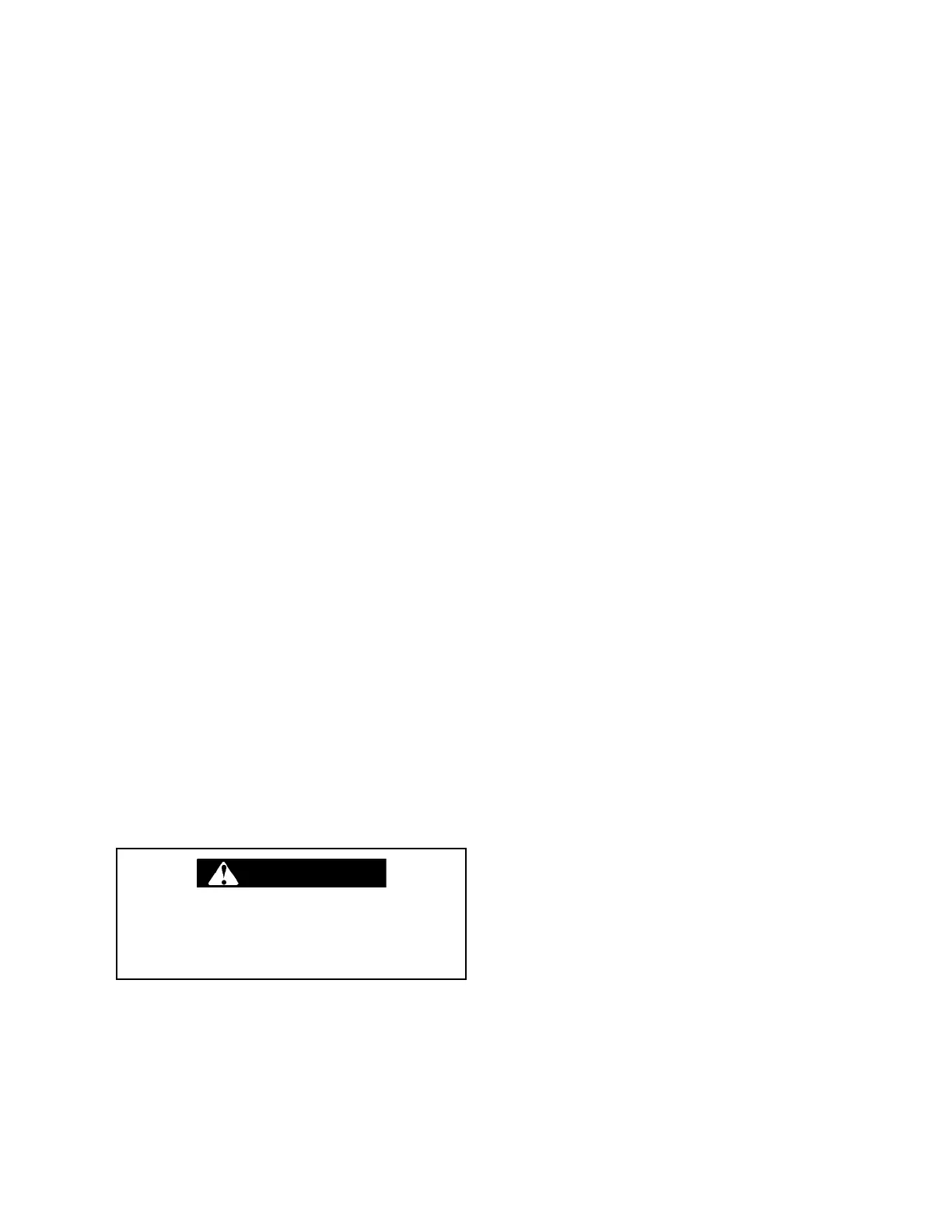Section 1
SAFETY
6
G. Disconnect the grounded negative battery con-
nection to prevent accidental engine operation prior
to attempting repairs or adjustments. Tag the bat-
tery connection so others will not unexpectedly
reconnect it.
H. When adjusting the controls, it may require oper-
ation of the equipment during adjustment. DO NOT
come in contact with any moving parts while adjust-
ing the control regulator and setting the engine
RPM. Make all other adjustments with the engine
shut off. When necessary, make adjustment, other
than setting control regulator and engine RPM, with
the engine shut off. If necessary, start the engine
and check adjustment. If adjustment is incorrect,
shut engine off, readjust, then restart the engine to
recheck adjustment.
I. Keep hands, feet, floors, controls and walking
surfaces clean and free of fluid, water, antifreeze or
other liquids to minimize possibility of slips and
falls.
1.6 HOT SURFACES, SHARP EDGES AND SHARP
CORNERS
A. Avoid bodily contact with hot fluid, hot coolant,
hot surfaces and sharp edges and corners.
B. Keep all parts of the body away from all points of
air discharge and away from hot exhaust gases.
C. Wear personal protective equipment including
gloves and head covering when working in, on or
around the compressor.
D. Keep a first aid kit handy. Seek medical assis-
tance promptly in case of injury. DO NOT ignore
small cuts and burns as they may lead to infection.
1.7 TOXIC AND IRRITATING SUBSTANCES
A. DO NOT use air from this compressor for respi-
ration (breathing) except in full compliance with
OSHA Standards 29 CFR 1920 and any other
Federal, State or Local codes or regulations.
B. DO NOT use air line anti-icer systems in air lines
supplying respirators or other breathing air utiliza-
tion equipment and DO NOT discharge air from
these systems into unventilated or other confined
areas.
C. Operate the compressor only in open or well-
ventilated areas.
D. If the compressor is operated indoors, discharge
engine exhaust fumes outdoors.
E. Locate the compressor so that exhaust fumes
are not apt to be carried towards personnel, air
intakes servicing personnel areas or towards the air
intake of any portable or stationary compressor.
F. Fuels, fluids, coolants, lubricants and battery
electrolyte used in the compressor are typical of the
industry. Care should be taken to avoid accidental
ingestions and/or skin contact. In the event of
ingestion seek medical treatment promptly. DO
NOT induce vomiting if fuel is ingested. Wash with
soap and water in the event of skin contact.
G. Wear an acid-resistant apron and a face shield
or goggles when servicing the battery. If electrolyte
is spilled on skin or clothing, immediately flush with
large quantities of water.
H. Ethyl ether used in diesel engine ether starting
aid systems is toxic, harmful or fatal if swallowed.
Avoid contact with the skin or eyes and avoid
breathing the fumes. If swallowed, DO NOT induce
vomiting, but call a physician immediately.
I. Wear goggles or a full face shield when testing
ether starting aid systems or when adding
antifreeze compound to air line anti-icer systems.
Keep openings of valve or atomizer tube of ether
starting aid system pointed away from yourself and
other personnel.
J. If ethyl ether or air line anti-icer system
antifreeze compound enters the eyes or if fumes
irritate the eyes, they should be washed with large
quantities of clean water for 15 minutes. A physi-
cian, preferably any eye specialist, should be con-
tacted immediately.
K. DO NOT store ether cylinders or air line anti-icer
system antifreeze compound in operator’s cabs or
in other similar confined areas.
L. The antifreeze compound used in air line anti-
icer systems contains methanol and is toxic, harm-
ful or fatal if swallowed. Avoid contact with the skin
or eyes and avoid breathing the fumes. If swal-
lowed, induce vomiting by administering a table-
spoon of salt in each glass of clean warm water
until vomit is clear, then administer two tablespoons
of baking soda in a glass of clean water. Have
patient lay down and cover eyes to exclude light.
Call a physician immediately.
1.8 ELECTRICAL SHOCK
A. Keep the towing vehicle or equipment carrier,
Death or serious injury may occur from inhaling
compressed air without using proper safety
equipment. See OSHA standards, and/or any
Federal, State or Local codes or regulations on
safety equipment.
DANGER

